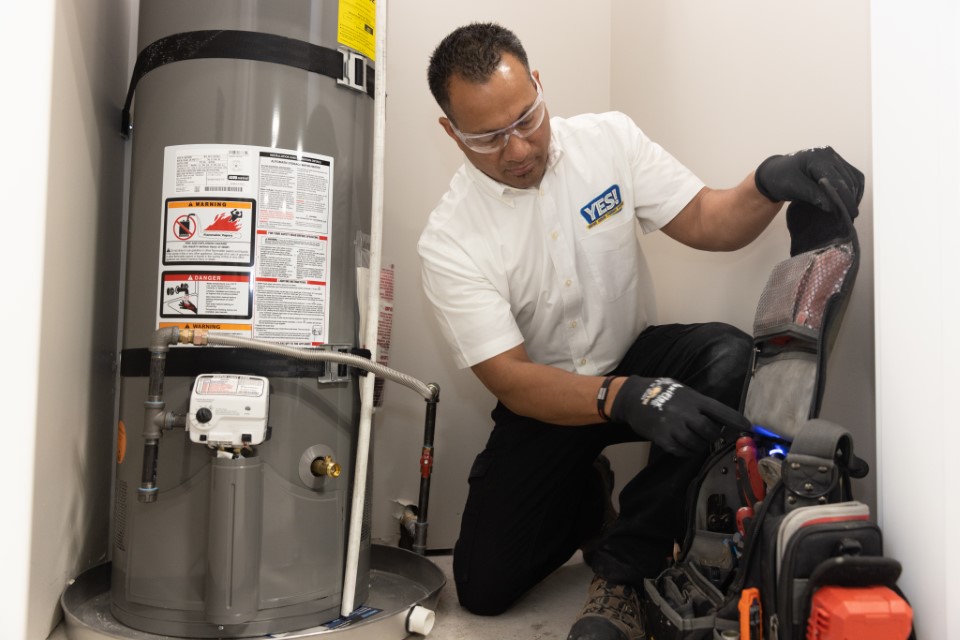How to Flush a Water Heater: 7 Clear Steps to Follow
May 04, 2023

Tank for indirect heating of boiler, flow filter for fine cleaning, boiler piping and meters in boiler room of private house
When looking into how to flush your water heater, it’s easy to feel intimidated at first. There’s a good chance you never covered the topic in school, and mom and dad may have never taken you aside to have an important talk about water heaters. But don’t worry—you’re not the first homeowner who didn’t know how to flush a hot water heater. Luckily, the experts at Yes! are here to help you.
Why Does It Matter?
You get home after a long day of work. You’re sweaty and tired, and all you want to do is take a nice shower and relax, but when you turn it on, you get less than five minutes of hot water. Water heaters need regular maintenance, and flushing yours is one way to ensure it keeps up with your family’s demands.
Everything can be cleaned in some way or another, including your water heater. When you don’t flush your water heater, all sorts of bacteria build-up. That bacteria affects your water heater’s quality—and too much neglect may lead you into an accidental ice bath challenge.
Without proper maintenance, you may end up needing to call the water heater repair experts sooner than you’d like.
How to Tell Your Water Heater Needs to be Flushed
As previously stated, one of the telltale signs that your water heater needs to be flushed is lukewarm or even cold water coming out of your faucets. Keep an eye out for debris suddenly showing up in your water. If you notice sediment or any brown sludge coming out of your faucet, that’s probably an indication that it’s time for a water heater flush.
If you see any of these signs, it’s a good indication that your water heater needs maintenance.
How to Flush a Water Heater in 7 Steps
Flushing your water heater can be a complex and sometimes intimidating process, but we’ve outlined 7 detailed steps to follow.
Step 1: Turn Off the Water Heater’s Thermostat
How to do this depends on what model you have. Check the manual for specifics, but here are some general tips:
- Look for an Off button toward the bottom of your water heater.
- If you’re dealing with an electric water heater, you’ll need to look for your home’s breaker box and turn off the switch that supplies power to the unit.
- If your model is older, you may need to relight the pilot light before being able to use the heater again.
Step 2: Turn Off the Gas Supply
This is a crucial step when you need to flush a gas water heater. The Off button should be located on the pipe leading to your thermometer. Once you switch that off, you’re good to move to step three.
Step 3: Turn Off the Water Supply
Toward the top of your water heater, you’ll find a switch or valve handle that controls the cold water flow. Use it to turn off the cold water.
Step 4: Turn On Your Hot Water In a Tub or Sink
Locate the faucet closest to the water heater and turn on the hot water. Doing so will drain your hot water and release the pressure from the tank.
Step 5: Connect the Drainage Spigot
Unless you already have a hose connected to your hot water heater, you can use your garden hose for this step. Connect one end to the drainage spigot, and put the other in a secure place, like a large bucket or a bowl, where it can drain safely.
Step 6: Turn on the Spigot and Drain
Flushing a water heater requires a watchful eye. Once you turn on the spigot, keep an eye on the quality of the draining water. You won’t want to stop draining the heater until the water runs clear.
If your water is discolored or has sediment coming out, your water heater certainly needs flushing. If you find your water isn’t clearing up, you may need to drain the water to clean it properly.
Step 7: Flush
In order to flush your water heater, you’ll need to turn on the cold water spout and let it run for a few minutes. Keep a close eye on the water coming through the hose. Again, you’re watching for the water to run clear. Once it does, you’re all done with the flushing process.
How to Flush a Tankless Water Heater
A lot of the prep work for a tankless water heater follows the same steps as a conventional heater, but there are some important differences. You’re going to want to use vinegar or a dedicated water heater cleaner to get all the sentiment out. See your water heater’s manual for ideas.
Using a submersible pump is also very valuable since a tankless water heater doesn’t have the reservoir of water used for flushing that a traditional heater does. This can make the whole process much faster.
If you don’t have access to a pump, it may make sense to bring in the professionals. Manually flushing a tankless water heater can take hours or even days.
After Flushing Your Water Heater
Your first step is to turn off your cold water spout and then turn off the hot water you turned on in a nearby faucet. Turn the cold water on instead.
If everything has been done correctly, cold water will come from the faucet. Turn the tap off, then turn the gas back on, if necessary. Relight the pilot light, turn your thermometer back on, and flip the electrical breaker if you have an electric heater.
After about 20 minutes, you should have hot water again—and a much more efficient system.
How Often Should You Flush Your Water Heater?
Your water heater must be flushed at least once a year—even if you’re not experiencing any issues. This is regular maintenance that can reduce the chance that serious problems will arise. If you start seeing signs of a problem before the year is up, you can flush your heater more often—it won’t hurt anything to try it.
When You Need a Professional
You can probably flush your water heater on your own, if you have the skills, the tools, and the time to do so. But if you don’t want to put the time in or want to ensure it’s done right, you can always turn to the professionals.
At Yes! we have the expertise to handle all your water heater needs, from regular flushings and other maintenance to repairs and replacements. For additional information on plumbing services, call our team at 844-216-9300 and speak with a technician today.
